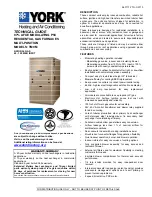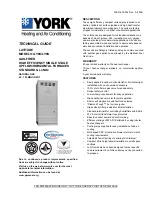
18. Check for proper blower operation in heating and cooling.
C.
Cleaning Heat Exchanger
The following steps should be performed by a qualified service
technician:
NOTE:
Deposits of soot and carbon indicate the existence of a
problem which needs to be corrected. Take action to correct the
problem.
If it becomes necessary to clean the heat exchanger because of
carbon deposits, soot, etc., proceed as follows:
1. Turn gas and power to furnace to OFF.
2. Remove control and blower access doors.
3. Disconnect wires to the following components. Mark wires
to aid in reconnection of:
a. Draft safeguard switch.
b. Inducer motor.
c. Pressure switch(es).
d. Limit overtemperature switch(es).
e. Gas valve.
f. Hot surface igniter.
g. Flame-sensing electrode.
h. Wiring connectors leading to control.
4. Remove 2 screws that secure relief box. (See Fig. 4.)
5. Remove complete inducer assembly from flue collector
box, exposing flue openings.
6. Remove 8 screws that secure flue collector box to center
panel. Be careful not to damage sealant.
7. Using field-provided small wire brush, steel spring cable,
reversible electric drill, and vacuum cleaner, clean cells as
follows:
a. Assemble wire brush and steel spring cable.
(1.) Use 48 in. of 1/4-in. diameter high-grade steel
spring cable (commonly known as drain clean-out
or Roto-Rooter cable).
(2.) Use 1/4-in. diameter wire brush (commonly known
as 25-caliber rifle cleaning brush).
NOTE:
The materials needed in items (1.) and (2.) can usually be
purchased at local hardware stores.
(3.) Insert twisted wire end of brush into end of spring
cable, and crimp tight with crimping tool or strike
with ball-peen hammer. TIGHTNESS IS VERY
IMPORTANT.
(4.) Remove metal screw fitting from wire brush to
allow insertion into cable.
b. Clean each heat exchanger cell.
(1.) Attach variable-speed, reversible drill to end of
spring cable (end opposite brush).
(2.) Remove cell outlet plates. IMPORTANT: Replace
screws in center panel to secure heat exchanger
cells before cleaning.
(3.) Insert brush end of cable into upper opening of cell
and slowly rotate with drill. DO NOT force cable.
Gradually insert at least 36 in. of cable into 2 upper
passes of cell. (See Fig. 5.)
(4.) Work cable in and out of cell 3 or 4 times to obtain
sufficient cleaning. DO NOT pull cable with great
force. Reverse drill and gradually work cable out.
(5.) Remove burner assembly and cell inlet plates.
NOTE:
Be very careful when removing the burner assembly to
avoid breaking the igniter. See Fig. 6 for the correct igniter
location.
(6.) IMPORTANT: Replace screws in center panel to
secure heat exchanger cells before cleaning.
(7.) Insert brush end of cable in lower opening of cell,
and proceed to clean 2 lower passes of cell in same
manner as 2 upper passes.
(8.) Repeat foregoing procedures until each cell in
furnace has been cleaned.
(9.) Using vacuum cleaner, remove residue from each
cell.
(10.) Using vacuum cleaner with soft brush attachment,
clean burner assembly.
(11.) Clean flame sensor with fine steel wool.
(12.) Reinstall cell outlet plates and screws FIRST;
then, reinstall cell inlet plates and burner assem-
bly. Care must be exercised to center the burners
in the cell openings.
Fig. 5—Cleaning Heat Exchanger Cell
A91252
Fig. 6—Position of Igniter to Burner
A93347
BURNER
IGNITOR
11 32
"
7 8
"
C
L
C
L
IGNITOR
ASSEMBLY
CELL
PANEL
BURNER
13 32
"
HOT
SURFACE
IGNITOR
ASSEMBLY
—4—
→
→






























